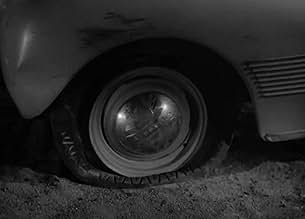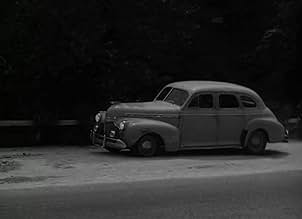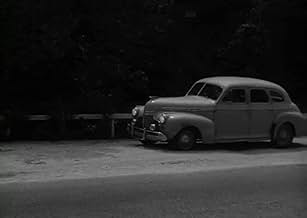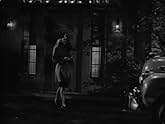IMDb RATING
6.7/10
2.4K
YOUR RATING
A mortally-wounded female gangster recounts how she and her gang revived an executed killer from the gas chamber to try to find out where he buried a fortune in cash.A mortally-wounded female gangster recounts how she and her gang revived an executed killer from the gas chamber to try to find out where he buried a fortune in cash.A mortally-wounded female gangster recounts how she and her gang revived an executed killer from the gas chamber to try to find out where he buried a fortune in cash.
Jean Gillie
- Margot Shelby
- (as Miss Jean Gillie)
Philip Van Zandt
- Tommy
- (as Phil Van Zandt)
Walden Boyle
- Chaplain
- (uncredited)
Martin Cichy
- Policeman
- (uncredited)
Tom Coleman
- Trucker at Roadside Inn
- (uncredited)
Franco Corsaro
- Kelsey
- (uncredited)
Madge Crane
- First Visitor
- (uncredited)
Dick Elliott
- Driver
- (uncredited)
Virginia Farmer
- Georgia - Margot's Maid
- (uncredited)
- Director
- Writers
- All cast & crew
- Production, box office & more at IMDbPro
Featured reviews
And makes Barbara Stanwyck and Ann Savage look like Ned(Jane?)in the first reader in the process. And, in "Decoy", femme fatality is a more apt term as all the male characters she encounters have less chance of surviving than Elisha Cook Jr. did going against Jack Palance in "Shane"...zip,nada,none,nought,zap and gone. Sheldon Leonard survives an encounter but only because she is dying when he shows up. The surprise is that she didn't take him out on the way out. Repeated viewings still figure him for no better than even at that. The taglines and blurbs on the posters and ads paint the following picture of her Margot Shelby character: "SHE TREATS MEN THE WAY THEY'VE BEEN TREATING WOMEN FOR YEARS!" Another line defines that as; "She Two-Times, Steals, Cheats, Double-Crosses...Anything To Get What She Wants...and then KISSES THEM OFF." Actually, she runs a car over Edward Norris, which was lack of good judgement on his part for hanging around with a broad known for..."kissing quick and killing quicker." She takes doctor Herbert Rudley away from Marjorie Woodworth,as she needs him to revive her just-executed in the gas chamber boy friend---no lack of plot in this one---which accounts for the only credibility gap in the film...somebody please tell me why Marjorie Woodworth wanted Herbert Rudley in the first place. Good riddance,Marjorie, you can do better although, come to think of it, you seldom did. Gillie gives Rudley a shovel, makes him dig up the buried money and then, in payment for past favors and services, shoots him dead. She had to double check to make certain as there wasn't much difference in his performance either way. Bottom line: Jean Gillie gets a wing to herself in the Femme Fatale Hall of Fame.
(April, 2000): Just saw a rare print at the American Cinematheque Noir festival and the film knocked my socks off. As evidenced by this performance, Jean Gillie would have been one of the greats of Noir had she not died in 1949. She powers through this film, getting man after man to do her bidding, never taking no for an answer. And the obstacles that would stop a lesser character don't bother her in the least. The problem confronting her: her boyfriend is on death row. Only he knows where $400,000 from a robbery is. And she uses her feminine wiles to persuade him, and two other men, to discern the location of that dough because, *she wants that money.* Even the gas chamber doesn't slow her down ... which is where the slight sci-fi element is introduced. If this turns up on late-night video, set your VCR. You will be amazed.
A stingingly bizarre noir entry every fan should seek out. Why? First, this ultra-rare crime drama has one of the two or three most ruthless and irredeemable femme fatales in B+W history, Margot Shelby, as blisteringly portrayed by standout brit Jean Gillie. Second, it features one of the strangest hybrid sci-fi/noir premises, introducing an exotic chemical to reincarnate the dead as the conceit to get Margot's man-slaughtering act started. Third, it all actually comes together in this strangely involving prison breakout cum road picture, which takes us all the way from the death chamber to a grove of trees in the woods (another death chamber) and back to where it all began, in a family's quiet suburban house (still another death chamber).
Once you get past the reincarnation, the plot is fairly conventional set pieces which mostly hold up and which benefit from a honey of a twist at the end. Along the way there, we get to see greed, betrayal, spinelessness, insanity, bravery, more betrayal, submission, redemption and more Jean Gillie, whose gin blossom charm and hyena-like guffaw at once blends Richard Widmark's killing debut in KISS OF DEATH with the murderous cackle of SPECTRE in the mirrored killmaze in MAN WITH THE GOLDEN GUN. Either way, she is death and she is irresistible. As is this movie. Find it and you'll see.
Once you get past the reincarnation, the plot is fairly conventional set pieces which mostly hold up and which benefit from a honey of a twist at the end. Along the way there, we get to see greed, betrayal, spinelessness, insanity, bravery, more betrayal, submission, redemption and more Jean Gillie, whose gin blossom charm and hyena-like guffaw at once blends Richard Widmark's killing debut in KISS OF DEATH with the murderous cackle of SPECTRE in the mirrored killmaze in MAN WITH THE GOLDEN GUN. Either way, she is death and she is irresistible. As is this movie. Find it and you'll see.
When Jean-Luc Godard dedicated Breathless to Monogram Pictures, foremost in his memory must have been Decoy. It's a movie whose reputation, over the years, has grown into folklore, because it's all but impossible to view or obtain. For aficionados of film noir, it has attained the stature of a Holy Grail (or Maltese Falcon), a fabulous treasure the quest for which seems doomed to futility. It has, however, showed up at festival screenings, and now circulating, in samizdat as it were, is a subtitled copy taped from Croatian television.
While probably it can't ever live up to the inflated legend that trails in its wake, it's decidedly no disappointment. Monogram and its raffish rivals on Poverty Row shot fast and cut corners, working from fast-and-loose scripts full of implausible chunks of plot for viewers either to swallow or choke on. Usually, the results were shoddy and forgettable. But now and again enough elements came together to generate unexpected chemistry. Decoy marks one such serendipitous occasion.
The key element in this explosive reaction is Jean Gillie, an English actress whose early death in 1949 deprived cinema of one of its darkest Jezebels. Like her compatriot Peggy Cummins (Annie Laurie Starr in Gun Crazy), she makes no attempt, as Margot Shelby, to Americanize her origins; in explanation, Decoy lets her spit out her contempt for poverty in an eloquent aria about that 'dingy, dirty street' that 'runs all over the world,' and through the sooty mill town in England she came from. She vows never to go back to want, and her unquenchable greed powers the plot.
Tricked out in haut-forties snoods, stoles, muffs and dead-serious hats, Gillie cuts a swath through the various men who stand between her and the $400-grand stolen by her gangster boyfriend (Robert Armstrong. Trouble is, he's the only one who knows where it's stashed but won't tell even though he's on death row.
But her days as a high-maintenance moll have taught her a thing or two, one of them that a tincture called Methylene Blue can reverse an execution by cyanide. She works her wiles on maverick mobster Edward Norris and an idealistic doctor who does prison autopsies (Herbert Rudley), enlisting them in her gruesome scheme. They hijack the fresh corpse, en route to an 'oven job,' and, in a sequence reminiscent of Frankenstein, bring it back to life.
Still, the tight-fisted old zombie won't trust them, instead roughing out a map to the buried strongbox but keeping half (why just half?) against the prospect of this second coming's failing to take. It's a turn of events that kicks Gillie's avarice into lethal overdrive....
Though the movie wouldn't be remarkable without Gillie, it shows a fair amount of craft. From his 11 recorded directorial credits, Jack Bernhardt couldn't have been expected to contribute much, but he adds some arresting details (a sprung window shade in the doctor's office among them) and an offbeat pace. He splits the ending in two, leaving half in its proper place and opening the movie with the other, in a gas-station men's room where the shattered mirror and filthy sink outdo one another as emblems of last-ditch squalor. Police detective Sheldon Leonard figures prominently in those two segments; the rest of the movie is told in extended flashback.
There's barely a moment when Gillie isn't front and center, for which gratitude should be fulsome. She delivers a go-for-broke performance, short on nuance but long on the flamboyant gesture. She coldly guns the motor to run down one of her victims, skitters into hysterical giggles when she shoots the next, and, dying, laughs in Leonard's face after coaxing him to kiss her ('Jo Jo, just this once, come down to my level'). She's a knockout, and because of her the elusive Decoy, despite the inevitable shortcomings of its Monogram origins, can be counted a knockout, too film noir with no frills.
While probably it can't ever live up to the inflated legend that trails in its wake, it's decidedly no disappointment. Monogram and its raffish rivals on Poverty Row shot fast and cut corners, working from fast-and-loose scripts full of implausible chunks of plot for viewers either to swallow or choke on. Usually, the results were shoddy and forgettable. But now and again enough elements came together to generate unexpected chemistry. Decoy marks one such serendipitous occasion.
The key element in this explosive reaction is Jean Gillie, an English actress whose early death in 1949 deprived cinema of one of its darkest Jezebels. Like her compatriot Peggy Cummins (Annie Laurie Starr in Gun Crazy), she makes no attempt, as Margot Shelby, to Americanize her origins; in explanation, Decoy lets her spit out her contempt for poverty in an eloquent aria about that 'dingy, dirty street' that 'runs all over the world,' and through the sooty mill town in England she came from. She vows never to go back to want, and her unquenchable greed powers the plot.
Tricked out in haut-forties snoods, stoles, muffs and dead-serious hats, Gillie cuts a swath through the various men who stand between her and the $400-grand stolen by her gangster boyfriend (Robert Armstrong. Trouble is, he's the only one who knows where it's stashed but won't tell even though he's on death row.
But her days as a high-maintenance moll have taught her a thing or two, one of them that a tincture called Methylene Blue can reverse an execution by cyanide. She works her wiles on maverick mobster Edward Norris and an idealistic doctor who does prison autopsies (Herbert Rudley), enlisting them in her gruesome scheme. They hijack the fresh corpse, en route to an 'oven job,' and, in a sequence reminiscent of Frankenstein, bring it back to life.
Still, the tight-fisted old zombie won't trust them, instead roughing out a map to the buried strongbox but keeping half (why just half?) against the prospect of this second coming's failing to take. It's a turn of events that kicks Gillie's avarice into lethal overdrive....
Though the movie wouldn't be remarkable without Gillie, it shows a fair amount of craft. From his 11 recorded directorial credits, Jack Bernhardt couldn't have been expected to contribute much, but he adds some arresting details (a sprung window shade in the doctor's office among them) and an offbeat pace. He splits the ending in two, leaving half in its proper place and opening the movie with the other, in a gas-station men's room where the shattered mirror and filthy sink outdo one another as emblems of last-ditch squalor. Police detective Sheldon Leonard figures prominently in those two segments; the rest of the movie is told in extended flashback.
There's barely a moment when Gillie isn't front and center, for which gratitude should be fulsome. She delivers a go-for-broke performance, short on nuance but long on the flamboyant gesture. She coldly guns the motor to run down one of her victims, skitters into hysterical giggles when she shoots the next, and, dying, laughs in Leonard's face after coaxing him to kiss her ('Jo Jo, just this once, come down to my level'). She's a knockout, and because of her the elusive Decoy, despite the inevitable shortcomings of its Monogram origins, can be counted a knockout, too film noir with no frills.
This movie, recently made available through a set of film noirs (Volume 4) packaged with two on each disc, gets points for originality. I mean, how many movies - much less film noirs - do you see someone executed, then brought back to life, then shot in the back minutes later? Now that's what you call having a rough day!
Robert Armstrong's "Frank Olins" had to endure all that one day. He's the crook who has the money stashed away somewhere and "Margot Shelby" (Jean Gille) is the woman who is bound-and-determined to get it - all of it. "Frank" claims a few times that if he isn't going get the money when he gets out of jail, nobody will and those aren't words that "Margot" wants to hear! Frank knew this dame and other members of his gang, most notably "Jim Vincent" (Edward Norris) were not trustworthy.
Well, he certainly was right about "Margot." She's the femme fatale - one mean mother - who has only one thing on her mind: money. She never wants to return to her old, poor, dingy ways of her youth in small town England. Now, she's in America, part of gang and she knows how to manipulate men. Of course it helps to be extremely pretty and have a great body, which she does. She plays the men and, well.....like most noirs, the ending is not particularly a happy one for most of the characters in this story.
Personally, in this film I enjoyed seeing a lot of familiar faces from TV programs and such of the 1950s, beginning with a young Sheldon Leonard who plays the tough, pursing cop in this movie. I also thought Armstrong sounded a lot better than in his early '30s adventure stories. Speaking of sound, the music in here was ill-timed, dominating some scenes which took away from the dialog.
Make no mistake, though: this is Gilles' movie. For classic movie fans and particular film noir buffs, this is worth checking out. It's always fun to see a new "face," and that certainly applies to Gillis, whose character reminded me a bit of Peggy Cummins' one in "Gun Crazy."
I thought the ending of this film - the final minute - was especially good. So many times, you get the ending that doesn't stay true to the main character, but this one did.
Robert Armstrong's "Frank Olins" had to endure all that one day. He's the crook who has the money stashed away somewhere and "Margot Shelby" (Jean Gille) is the woman who is bound-and-determined to get it - all of it. "Frank" claims a few times that if he isn't going get the money when he gets out of jail, nobody will and those aren't words that "Margot" wants to hear! Frank knew this dame and other members of his gang, most notably "Jim Vincent" (Edward Norris) were not trustworthy.
Well, he certainly was right about "Margot." She's the femme fatale - one mean mother - who has only one thing on her mind: money. She never wants to return to her old, poor, dingy ways of her youth in small town England. Now, she's in America, part of gang and she knows how to manipulate men. Of course it helps to be extremely pretty and have a great body, which she does. She plays the men and, well.....like most noirs, the ending is not particularly a happy one for most of the characters in this story.
Personally, in this film I enjoyed seeing a lot of familiar faces from TV programs and such of the 1950s, beginning with a young Sheldon Leonard who plays the tough, pursing cop in this movie. I also thought Armstrong sounded a lot better than in his early '30s adventure stories. Speaking of sound, the music in here was ill-timed, dominating some scenes which took away from the dialog.
Make no mistake, though: this is Gilles' movie. For classic movie fans and particular film noir buffs, this is worth checking out. It's always fun to see a new "face," and that certainly applies to Gillis, whose character reminded me a bit of Peggy Cummins' one in "Gun Crazy."
I thought the ending of this film - the final minute - was especially good. So many times, you get the ending that doesn't stay true to the main character, but this one did.
Did you know
- TriviaMethylene blue is a real chemical compound, discovered in 1896 (by Heinrich Caro), which does indeed have the ability to counteract cyanide poisoning. This property was discovered in 1933 by Dr. Matilda Moldenhauer Brooks of San Francisco. It will not, however, restore life to those who have died from cyanide poisoning.
- GoofsWhen Joe walks into the bar, he pauses by the piano. The piano player raises his left hand off the keyboard to wave to Joe, but the piano music continues as if both his hands are still playing.
- Quotes
Sergeant Joe Portugal: Don't let that face of yours go to your head.
Margot Shelby: Or to yours?
Sergeant Joe Portugal: It wouldn't matter if did... People who use pretty faces like you use yours, don't live very long anyway.
- ConnectionsFeatured in Film Noir: Bringing Darkness to Light (2006)
- How long is Decoy?Powered by Alexa
Details
- Runtime
- 1h 16m(76 min)
- Color
- Aspect ratio
- 1.33 : 1
Contribute to this page
Suggest an edit or add missing content































